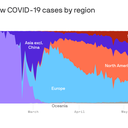The eye of the coronavirus storm shifts to Latin America

Published Date: 5/28/2020
Source: axios.com
Data: The Center for Systems Science and Engineering at Johns Hopkins; Chart: Naema Ahmed/AxiosThe epicenter of the COVID-19 pandemic has moved from China to Europe to the United States and now to Latin America.Why it matters: Up until now, the pandemic has struck hardest in relatively affluent countries. But it's now spreading fastest in countries where it will be even harder to track, treat and contain.Driving the news: Brazil is now recording more deaths each day than any other country, surpassing the U.S. for the first time over the past three days.Outbreaks are also growing fast in Mexico, Peru and Chile, with those countries now recording more new cases than any country in Europe, excluding Russia. The World Health Organization is also worried about rising caseloads in El Salvador, Guatemala and Nicaragua. As cases surge, poorly equipped health care systems throughout the region will struggle to cope. In Mexico, at least 11,000 health care workers have themselves become sick, per the NYT.A University of Washington study forecasts a sharp rise in fatalities in the region by early August — including 125,000 in Brazil, up from 24,512 now, per Reuters.President Jair Bolsonaro, who has repeatedly dismissed the threat from the virus, is battling with local officials to reopen the economy even as the situation grows increasingly grave.Data: The Center for Systems Science and Engineering at Johns Hopkins; Map: Axios VisualsZoom out: Indian Prime Minister Narendra Modi has taken the outbreak far more seriously, implementing one of the world's strictest lockdowns, but his government is now loosening restrictions not because cases are falling (they're not) but because the economy is buckling.“In India, the curve hasn’t turned the corner. You have deferred the peak," says Bhramar Mukherjee, who leads a University of Michigan project that projects India will have 1 million cases by July 15 if it pursues a "cautious" reopening, per the Washington Post.Overall case counts have increased by 4.5x in India, 3.7x in Pakistan and 2.4x in Indonesia — the world's second-, fifth- and fourth-most populous countries, respectively — since May 1, per WHO data.The global picture: Countries across East Asia, where the virus arrived earlier, now have fewer active cases than they did a week ago, according to Albright Stonebridge Group. That's also the case in most of Europe.But in sub-Saharan Africa, as in Latin America, the numbers climbed almost everywhere over the past week.They spiked dramatically in countries like Cameroon (+198%), South Africa (+172%) and Bangladesh (+41%).Many of these countries are starting from low baselines, largely because they'd conducted so few tests.Data: IRC; Chart: Axios VisualsNigeria, for example, has tested just one person for every 230 tested in the U.S. (adjusted for population), according to data compiled by the International Rescue Committee."We've got countries where there are hardly any tests going on at all," David Miliband, the IRC's CEO, told Axios in an interview, "and we've got countries ... where we're getting enough testing to be very worried."The lack of tests in many poorer countries can be attributed to political dysfunction, poor infrastructure and shortages of testing kits and lab capacity.In the Democratic Republic of the Congo, Miliband notes, samples have to be transported to labs in Kinshasa. That's no easy task in a country where very few cities are connected to the capital by road.In Tanzania, the government appears to be quite literally choosing ignorance. It has been a month since the country recorded a new case — or a single test.Russia's new approach, announced Wednesday, is more subtle. They'll keep conducting tests, but only add those showing COVID-19 symptoms to the tallies of cases and deaths.Go deeper: Pandemic brings Putin down to size